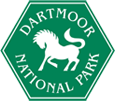Ponies
The ponies on Dartmoor are an integral part of the landscape and many people like to see these animals in their natural environment. They roam freely around the National Park and like all livestock, are owned by farmers.
When Dartmoor was designated a National Park in 1951, the pony was chosen to be its logo.
Ponies have roamed free on Dartmoor for at least four millennia. You can read more about the importance of ponies on Dartmoor on our pony heritage page.
